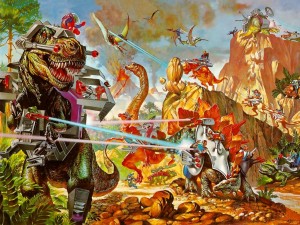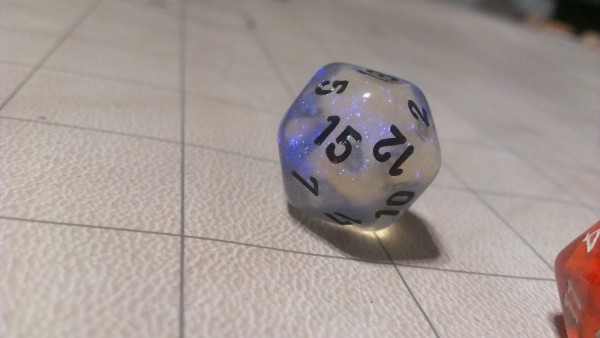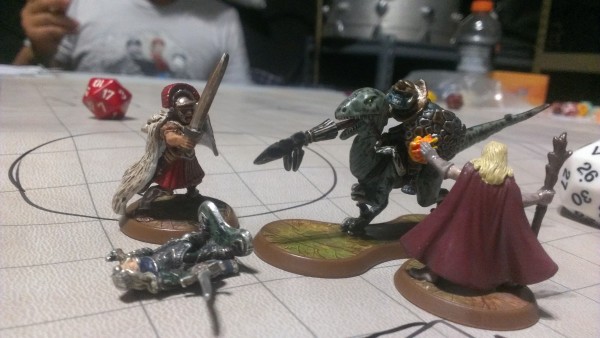I just played Dungeons & Dragons 5th Edition for the first time. You may know it as D&D Next or just straight up D&D, like other modern reboots.
I have some first impressions… before we get to that, though:
I’d like you all to know where I’m coming from. My first intro into Dungeons & Dragons was waaaay back when my 10-year old self randomly decided to pick up Dragonlance: Dragons of Autumn Twilight at my local B. Dalton Bookseller. At that age, I was already pretty enamored with the fantasy genre. Movies like The Neverending Story and Conan the Barbarian were among my favorites. I dreamed about riding skyward atop a dragon almost as much as I did about rocket launcher-equipped dinosaurs.

My first foray into actual pen & paper, tabletop Dungeons & Dragons happened during high school. Back then, we were playing D&D 2.5, complete with THAC0 charts and encumberance rules. The first character I ever rolled was a Human Paladin, Sariel Blade. He had this ridiculously large sword called Goblinslayer. It was the size of a tower shield, and had a smaller sword nested inside it, a la Cloud’s First Tsurugi from Advent Children. Depending on the encounter, he could switch between the giant two-hander, or pull out the smaller blade for some sword and board action.
Since then, I’ve played games in a few different systems, including D&D 3rd, Pathfinder, Dresden Files, D&D 4th Ed, and some other custom games dreamed up by my oh-so-creative friends. I’m not extremely well-versed, but I’ve had my fair share of gaming groups in the past; most recently a Pathfinder and a another D&D 2.5 group where I played a Grey Elf Bladesinger.
Soooooooooooooo… after one session, what did I think of 5E?
Overall, I liked it a lot.
I do have to disclose, however, that we’re playing a slightly modified version of 5E. My current DM has a long-running storyline that we’ve been playing through for the past couple of years in Pathfinder. He’s adapted the world to the 5E system by jumping ahead in the world’s timeline 100 years. Differences: No alignment, magic is very rare, and no halflings or other demi-humans besides elves, dwarves, and orcs. Also, being that magic is very rare, there are no sorcerors or warlocks in the game.
Other than that, it’s pretty much standard 5E. I think it’s a pretty cool world setting, which you can read about here: Veil: Bloodlines.
What did I decide to roll this time around? An Elven Paladin. It was between that and a Druid, but our party seemed to need some more front line meatshielding. I hadn’t played a Pally since my first ever D&D character in high school, so I didn’t mind at all.
My Favorite Thing About 5E? The advantage/disadvantage system. What’s it about? Well, basically anything that formerly required d20 plus a semi-lengthy tally of modifiers is now covered by advantage/disadvantage. Called shots? Advantage/Disadvantage. CMB/CMD for you Pathfinder heads? Advantage/Disadvantage. Attacking from prone, blind, flat-footed, blinded? It all comes down to Advantage/Disadvantage. Attempting to intimidate a platoon of kobolds with your ferocious barbarian-yell? Advantage/Disadvantage.
Basically, you state your intention and the DM will tell you if you have advantage or disadvantage in your situation. You get to roll two d20’s. If you have disadvantage, you take the lower of the two rolls, the higher if you have advantage. You still add modifiers, but it’s just the standardized modifier for the pertinent ability score (STR, CHA, DEX, etc.).
What this seems to do is streamline both the storytelling and combat portions of the game, which I’m all for. Less time is spent rules-lawyering, which means more game time. The more game we can get through and enjoy without having to break out the PHB or DMG, the better, says I.

Other things that felt different:
Character generation. There seems to be a more streamlined, directed path to creating a character – once you’ve chosen what you want to roll, of course. For people who don’t necessarily enjoy creating character backgrounds, the Player’s Handbook outlines several backgrounds, which help you by assigning certain character histories, personality traits, and general outlook to d8 or d6 dice rolls.
1st-level characters in general feel more useful than in some previous editions. Certain classes have more skills/spells at their disposal at 1st level than before, which will hopefully help with survivability in the lower levels and scale once a character gets above level 7 or so. Paladin, unfortunately, has little else besides Laying of Hands at 1st level, as their combat specialty is chosen at 2nd level, and cooler powers are learned later on. Seems I’m going to have to play another session or two before we find out how viable they are.
Proficiencies are streamlined. Much like Pathfinder streamlined the list of proficiencies to something manageable, D&D 5E has streamlined it into something quick. I suspect this will work well with Advantage/Disadvantage. I’ll find out for sure over the course of the next couple of sessions.
In Conclusion:
I’m excited to explore and learn this new system. Perhaps that excitement is mixed with excitement for exploring the the in-game world, but I suppose we’ll find out soon enough. Now, these are only my knee-jerk reactions after a single 5-hour session, most of which was character generation. So I’m sure my opinions of the system will evolve over the course of a few adventures.
Whether it be for better or worse… who knows? Either way, I hope to let you know here!


Comments